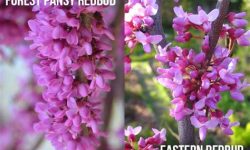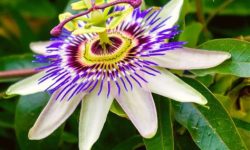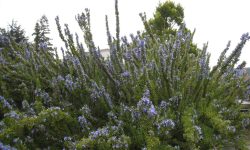Crape Myrtle Bush Vs Tree
Whether you’re a seasoned gardener or a flourishing green thumb, the Crape Myrtle—an emblem of beauty and resilience—offers a diverse palette for your landscape canvas. In this post, we’ll delve into the intrinsic characteristics and undeniable benefits of the Crape Myrtle Bush, unpack the growth patterns and maintenance tips for the towering Crape Myrtle Tree, and help you navigate the decision between the two. We won’t stop there; get ready to transform your outdoor space with creative landscaping ideas that showcase the versatility of Crape Myrtle varieties. And, for the cherry on top, we’ll guide you through the nuanced art of pruning, comparing techniques for both bushes and trees. Prepare to elevate your garden’s charm as we journey through the enchanting world of Crape Myrtles.
Crape Myrtle Bush: Characteristics and Benefits
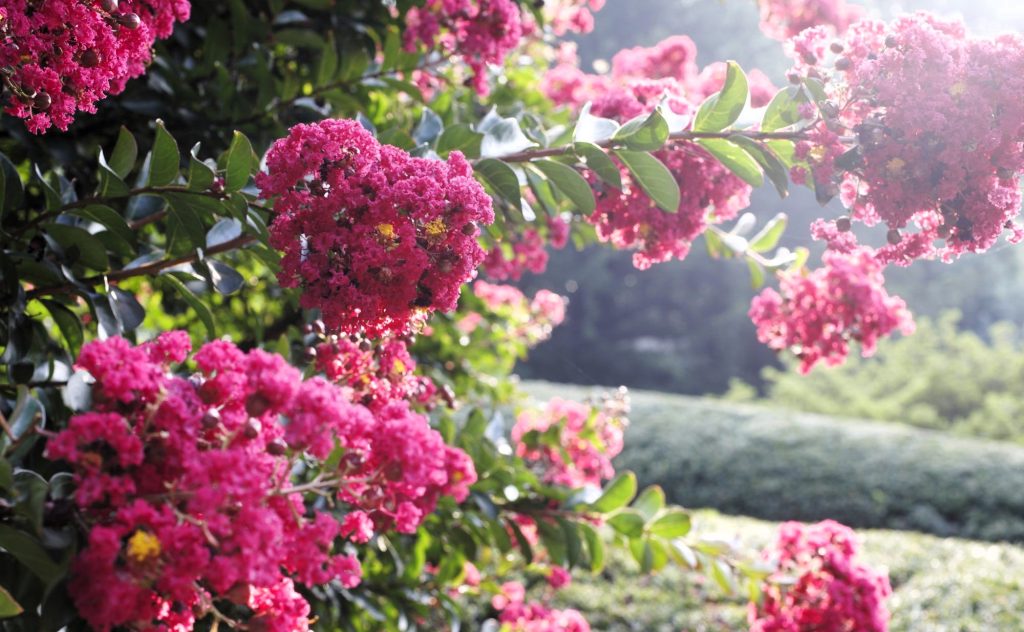
The Crape Myrtle Bush, known for its abundant and colorful blooms, is a breathtaking addition to any garden that desires a splash of vibrancy and a touch of southern charm. Recognized for their distinctive exfoliating bark and a variety of bloom colors that range from the softest pinks to the deepest reds, the Crape Myrtle Bush stands out with its potential to remain relatively compact, making it an ideal choice for those who wish to integrate ornamental beauty within smaller garden spaces or residential landscapes.
One significant benefit of the Crape Myrtle Bush is its more manageable size compared to its arboreal counterpart, which allows for greater flexibility in planting arrangements and easier access when it comes to routine pruning and care. Moreover, this deciduous shrub showcases remarkable drought tolerance once established, this inherent characteristic allows it to thrive in warmer climates where other plants might falter, and making it a valuable specimen for xeriscaping projects and water-wise garden designs.
In addition to its visual appeal and drought resilience, the Crape Myrtle Bush also brings forth the advantage of year-round interest; its foliage turns to a stunning display of autumnal colors before dropping, and its artful branches continue to contribute to the garden’s aesthetic in the winter. Furthermore, Crape Myrtles are known for their relatively fast growth rate and ability to attract pollinators such as butterflies and bees, enriching the local ecosystem while providing endless enjoyment to the attentive gardener and nature lovers alike.
The Crape Myrtle Bush therefore is not just a feast for the eyes; it represents a harmonious convergence of form and function within the sphere of horticulture. For anyone wanting to create an impact in their garden with a shrub that is both decorative and eco-friendly, the Crape Myrtle Bush is indeed an exemplary choice that offers a multitude of benefits throughout the changing seasons, reaffirming its well-deserved popularity amongst both novice and experienced gardeners.
Pros
- Drought tolerance
- Ideal for privacy barriers
Cons
- Requires more trimming and maintenance than the tree
Crape Myrtle Tree: Growth and Maintenance
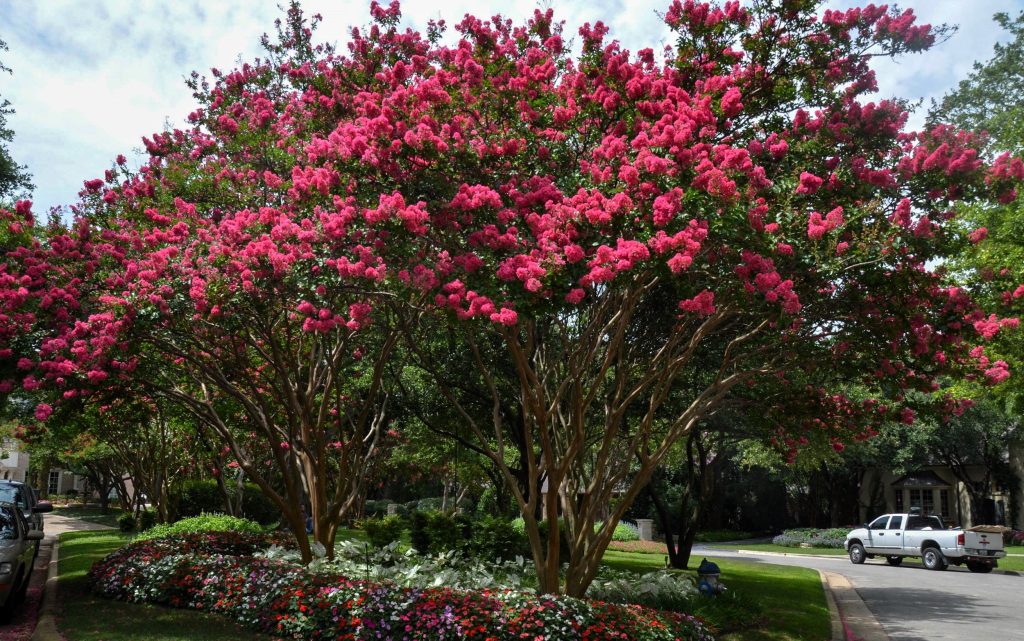
The Crape Myrtle Tree, known for its vibrant and long-lasting blooms, majestic growth habit, and relatively fuss-free maintenance, has become a landscaping favorite in many temperate regions. When considering the agronomy of this stunning plant, it is important to recognize that the cultivation begins with the choice of location; they thrive in full sun with good air circulation to minimize the risk of fungal diseases, which can sometimes plague these ornamentals.
Once established, the Crape Myrtle Tree demands minimal attention, yet reaps magnificent rewards. Watering is essential during the first few seasons of growth, fostering a robust root system. Thereafter, the tree exhibits drought tolerance, reflecting its ability to adapt to a variety of environments, though regular watering in extreme heat promotes optimal growth and flowering.
Feeding your Crape Myrtle Tree properly is pivotal; a balanced, slow-release fertilizer applied in early spring can encourage a flourish of growth and an abundance of blooms. Furthermore, understanding the pruning needs of the Crape Myrtle is crucial; light pruning to shape the tree and remove dead wood can be done in winter, but heavy pruning can lead to a less natural shape and fewer flowers.
Mulching is another key aspect of maintenance that cannot be overstated. A layer of organic mulch around the base of the tree not only conserves soil moisture and regulates temperature but also adds to the aesthetic appeal. In conclusion, with the appropriate care and attention, your Crape Myrtle Tree will become an enduring feature of your garden, delighting with its summer spectacle of blossoms year after year.
Pros
- Aesthetic enhancement for yards
- Excellent shade provider
- Non-invasive roots
Cons
- Susceptibility to pests
- Lack of cold tolerance
Choosing Between Crape Myrtle Bush and Tree
When considering the addition of Crape Myrtle to your garden, the decision between opting for the bush or tree form can significantly impact the overall aesthetic and functionality of your landscape design; it’s not merely a choice of size, but also one of structure, flowering patterns, and maintenance needs that should align with your gardening preferences and the environmental conditions of your location.
Understanding the distinction can be pivotal; the Crape Myrtle Bush is renowned for its multi-stemmed growth, giving it a fuller appearance suited for hedges or standalone splendor offering an effusion of blooms close to eye level, whereas the Crape Myrtle Tree, with its single or few stems, stands tall, presenting a more traditional tree silhouette that offers not only flowers but also the added architectural benefit of smooth, exfoliating bark and an elegant branching structure.
Choosing the bush variant may be preferable for those who desire a plant that can provide a robust display of flowers without the vertical dominance of a tree, whereas the tree form is ideal for gardeners looking to create a focal point or shade in specific areas; both choices come with their unique set of benefits, including seasonal interest with vibrant autumn leaf change and distinctive winter bark patterns, making them standout options irrespective of the form you select for your landscaping project.
Moreover, the decision between the Crape Myrtle Bush and Tree should not be made hastily; thoughtful consideration of your space, the height and spread desired, and the commitment to maintenance such as pruning are necessary to ensure the chosen type thrives and enhances your garden space for years to come, allowing you to enjoy the extended blooming season and spectacular color that these versatile plants provide.
Comparing Crape Myrtle Trees and Bushes
Size and Structure
| Crape Myrtle Tree | Crape Myrtle Bush |
|---|---|
| Up to 30 feet tall | 6–8 feet tall |
| Single trunk up to 2 feet diameter | Multiple thinner stems |
Flower and Foliage Comparison
| Tree Flowers | Bush Flowers |
|---|---|
| Up to 6 inches in diameter | About 3 inches wide |
| Tree Leaves | Bush Leaves |
|---|---|
| Up to 8 inches long | About 4 inches long |
Lifespan Differences
| Crape Myrtle Tree | Crape Myrtle Bush |
|---|---|
| Longer lifespan | Shorter lifespan (~10 years) |
Pruning Techniques: Bushes vs Trees
When it comes to pruning, understanding the nuances between bushes and trees can significantly impact the health and aesthetics of your plants. Pruning is not a one-size-fits-all task; instead, it requires a discerning eye and knowledge of plant structure. For instance, bushes tend to have a more compact form and require a detailed approach to encourage lush foliage and vibrant blooms, necessitating careful thinning of the interior branches to enhance sunlight penetration and air circulation.
Trees, on the other hand, often call for a distinct set of pruning techniques focused on promoting strong, stable growth and maintaining the overall tree shape. Formative pruning during the early life of a tree helps to establish a robust framework of primary branches, while mature trees require periodic crown thinning, deadwood removal, and the elimination of any branches that may pose a hazard or contribute to structural weakness.
The timing of pruning can also differ significantly; bushes such as the crape myrtle may benefit from pruning during late winter or early spring before they break dormancy, while trees may be best pruned in late fall or winter when they are in a state of dormancy, reducing the risk of pruning-related stress and the spread of diseases. It is crucial to adhere to these seasonal guidelines to ensure that both bushes and trees recover optimally and enter their respective growing seasons with vigor and resilience.
To further refine these pruning techniques, one must take into account the specific growth patterns and needs of the individual species; for example, pruning a crape myrtle tree may necessitate the removal of suckers and low-hanging branches to accentuate its multi-stemmed trunk and graceful canopy, while a crape myrtle bush may benefit from more frequent, lighter prunings to stimulate a profusion of flowers and maintain its desired shape and size within a garden space.
Frequently Asked Questions
What are the main differences between Crape Myrtle Bush and Tree varieties?
Crape Myrtle Bush varieties are generally shorter with multiple stems and a more compact shape, suitable for small gardens or as accent plants. The Crape Myrtle Tree, on the other hand, is characterized by a single trunk or a few main stems that grow much taller, making them ideal as specimen trees in larger landscapes.
What are some key characteristics and benefits of planting a Crape Myrtle Bush?
Crape Myrtle Bushes are known for their vibrant flowers, long blooming season, and relatively small size which makes them easy to fit into various garden designs. They require less maintenance than the tree varieties and are excellent for creating borders or adding color to foundation plantings.
How should I maintain a Crape Myrtle Tree to ensure optimal growth?
To maintain a Crape Myrtle Tree, provide well-draining soil and full sun exposure. Regular watering, especially during dry spells, and annual pruning to remove dead branches and promote air circulation are also crucial. Fertilization in early spring can support healthy growth and flowering.
What should be considered when choosing between a Crape Myrtle Bush or Tree for my garden?
Consider the size and layout of your garden, the desired height and spread of the plant, maintenance preferences, and whether you’re looking for a focal point or filler plant. Crape Myrtle Trees make for stunning focal points, while bushes are better for underplanting and filling gaps.
Can you provide some landscaping ideas that incorporate different Crape Myrtle varieties?
You can create a dynamic garden by mixing Crape Myrtle Bushes with perennials in a cottage-style border, or use Tree varieties to line a driveway for a dramatic entrance. Crape Myrtle Bushes can also be planted in groups for a burst of seasonal color or utilized as hedges for privacy.
Are there any particular pruning techniques that differ for Crape Myrtle Bushes compared to Trees?
Pruning techniques for Crape Myrtle Bushes involve thinning out crowded stems to encourage airflow and shape the bush. For Crape Myrtle Trees, it’s essential to avoid ‘topping’ and instead focus on removing lower branches to raise the canopy, as well as cutting away suckers, dead wood, and cross branches to maintain the tree’s structure.
Is it possible to train a Crape Myrtle Bush into a tree form?
Yes, it is possible to train a Crape Myrtle Bush into a tree form by selecting a few main stems and staking them upright while continually removing the lower growth and any additional suckers. This should be done over several years to achieve a strong, tree-like structure.

